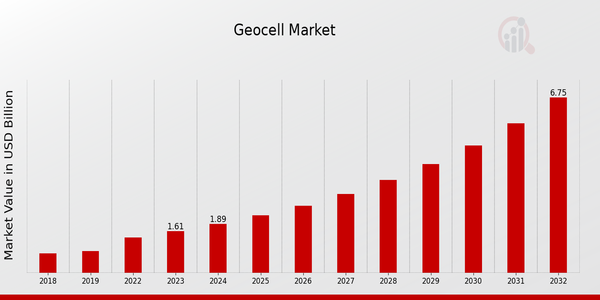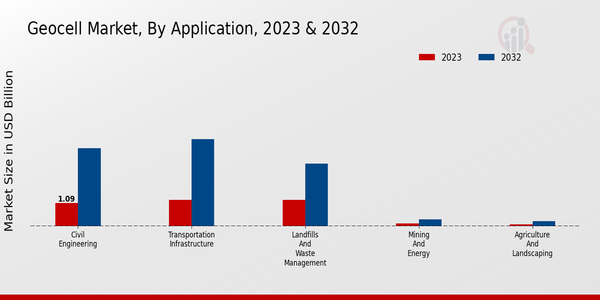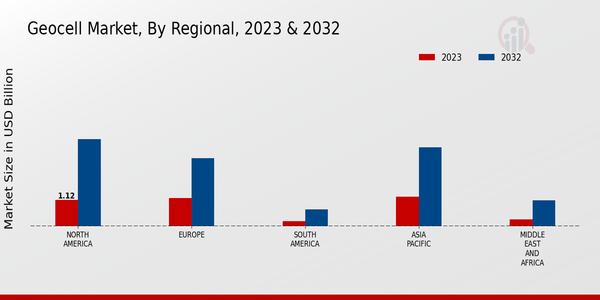Global Geocell Market Overview
As per MRFR analysis, the Geocell Market Size was estimated at 1.37 (USD Billion) in 2022. The Geocell Market Industry is expected to grow from 1.61(USD Billion) in 2023 to 6.75 (USD Billion) by 2032. The Geocell Market CAGR (growth rate) is expected to be around 17.28% during the forecast period (2024 - 2032).
Key Geocell Market Trends Highlighted
The geocell market is witnessing notable growth driven by increasing infrastructure development, particularly in emerging economies. Geocells are widely used in soil stabilization, erosion control, and reinforcement applications in infrastructure projects like road construction, bridges, and railways.
Key market drivers include increasing awareness of geocell benefits in ground stabilization and erosion control, rising urbanization and population growth leading to greater infrastructure demand, and government initiatives promoting infrastructure development. Opportunities exist in the exploration of innovative applications, such as in agriculture for soil stabilization and environmental protection for slope stabilization and erosion control.
Recent trends include the adoption of environmentally friendly geocells made from recycled materials, the integration of geocells with geotextiles and other materials for enhanced performance, and the development of lightweight and easy-to-install geocells for wider accessibility.

Source: Primary Research, Secondary Research, MRFR Database and Analyst Review
Geocell Market Drivers
Rising Demand for Infrastructure Development
The key driving factor for the global geocell market is the increasing demand for infrastructure development across the globe. They are widely used in the construction of roads, railways, airports, and other transportation-related structures. They provide a vast amount of benefits, such as soil stabilization, erosion control, slope protection, and the improvement of the load-bearing capacity of various grounds; therefore, they are perfect for infrastructure-related projects.
With governments and private organizations investing massive amounts of money into the development of infrastructure, the demand for geocell will only increase over the coming years. In addition, the growing levels of urbanization and overall population will also contribute to the increased demand for infrastructure development, therefore escalating the market growth even further.
Growing Environmental Concerns
It is crucial for governments and organizations all over the world to preserve environmental sustainability. At present, such issues as soil erosion control, slope stabilization, and water conservation are on the agenda, and it is essential to focus on finding solutions to these problems. In this regard, an increasing number of environmental projects adopt geocells because they are very effective in overcoming soil erosion, lessen the risks of landslides, and improve water control.
Since environmental regulations are getting more rigid and sustainability issues are of the essence, it is possible to forecast that the contribution of geocells to the global Geocell Market Industry will continue growing.
Technological Advancements
The rise of the global geocell market is also driven by technological advances. The development of novel and advanced materials and designs facilitates the improved performance and greater efficacy of geocells, inducing their increased application and high pervasiveness. Particularly, geocells enhanced by newly implemented drainage systems are applied for a broader range of purposes, while geocell advances in terms of load capacities extend their application areas.
Furthermore, new manufacturing techniques foster the economic efficacy of the product, causing its high usage.
Geocell Market Segment Insights
Geocell Market Application Insights
The application segment is one of the most crucial factors that determine the dynamics of the global Geocell Market. Among the most prominent applications since 2023 and beyond, civil engineering is anticipated to continue its dominate, fostering overall demand among the key application segments. The key factor that drives the demand for geocells in the context of civil engineering is an increasing call for infrastructure development, with the majority of efforts undertaken in emerging economies. The particular scope of activities where geocells are being used includes road construction, slope stabilization, and erosion control efforts.
The key benefits that geocells offer include the improved stability of soil and its reinforcement, as well as the overall affordability and simplicity of the installation process. An equally significant application that will define the dynamics of the global Geocell Market and that will continue gaining popularity in the specified period is transportation infrastructure. As the era of road and railway network expansion and renovation continues, transportation infrastructure will also be included in the category of geocell application, with the latter used for creating embankments, as well as retaining walls and bridge abutments, for creating structural backing and enhancing their ability to carry loads.
As such, the increased download of investments in transportation infrastructure development observed globally will serve to foster demand in the area of geocell application. Speaking of landfill and waste management applications, the overwhelming share of demand will most likely arise over the next decade. The urgency of the issue can be attributed to the fact that the demand for environmentally friendly and cost-effective waste management strategies has been on the rise. Throughout the specified scope, geocells have been used for landfill construction and stabilization.
The technology allows for the development of a stable ground for waste storage, and decreased settlements and improved drainage, have reinforced landfills and reduced their negative impacts on the environment. The application of geocells in the mining and energy segment provides another critical application that will polarize demand. First and foremost, with the growing demand for renewable sources, the need to produce the latter and enhance the rates of occupation has contributed to an overall increase in demand in the area. In mining, efforts to stabilize whole roads, reinforce haul slopes, and create temporary lax support and drilling platforms have resulted in the application of the technology.
Meanwhile, in the energy segment, geocells have been used for creating foundations for solar faucets and wind turbines and for providing ground support and anti-erosion tools. Finally, the application of geocells in agriculture and landscaping applications is a niche that is rapidly growing.

Source: Primary Research, Secondary Research, MRFR Database and Analyst Review
Geocell Market Material Insights
The Global Geocell Market is segmented by Material into High-Density Polyethylene (HDPE), Polypropylene (PP), Low-Density Polyethylene (LDPE), and Polyvinyl Chloride (PVC). HDPE is expected to dominate the market in the coming years due to its high strength, durability, and resistance to chemicals and UV radiation. PP is another popular material due to its good strength-to-weight ratio and flexibility. LDPE is a low-cost option that is often used in applications where flexibility is important. PVC is a versatile material that can be used in a variety of applications, but it is not as strong as HDPE or PP.
The growth of the market is attributed to the increasing demand for geocells in infrastructure development, mining, and agriculture. Geocells are used to stabilize soil, prevent erosion, and improve drainage. They are also used to create load-bearing structures, such as roads and railroads.
Geocell Market Structure Insights
The structure segment of the global geocell market is categorized into single-layer, multi-layer, and composite geocells. Single-layer geocells are the most widely used type, owing to their cost-effectiveness and ease of installation. Multi-layer geocells offer enhanced load-bearing capacity and are preferred for heavy-duty applications. Composite geocells combine the advantages of both single-layer and multi-layer geocells, providing high strength, durability, and flexibility. In 2023, the single-layer geocell segment held the largest market share, accounting for approximately 60% of the global geocell market revenue.
The multi-layer geocell segment is projected to grow at a CAGR of 8.5% during the forecast period, owing to increasing demand for high-performance geocells in infrastructure and construction projects. The composite geocell segment is expected to witness significant growth, driven by its superior properties and versatility.
Geocell Market Regional Insights
The regional segmentation of the Global Geocell Market offers valuable insights into the market's geographical distribution and growth dynamics. North America, Europe, APAC, South America, and MEA are the key regions contributing to the overall market growth. Among these, North America holds a significant market share due to the increasing adoption of geocells in infrastructure development and environmental protection projects. Europe is another major market driven by the growing demand for geocells in road construction and slope stabilization applications.
The APAC region is expected to witness substantial growth in the coming years, primarily attributed to the rapid urbanization and infrastructure development in countries like China and India. South America and MEA are emerging markets with untapped potential, offering significant growth opportunities for geocell manufacturers and suppliers.

Source: Primary Research, Secondary Research, MRFR Database and Analyst Review
Geocell Market Key Players And Competitive Insights
Leading Geocell Market players are constantly investing in research and development to create new and innovative products that meet the needs of their customers. This has led to the development of a wide range of geocells that are available in different sizes, shapes, and materials. This variety of products allows customers to choose the geocell that is best suited for their specific application. Major players in the Geocell Market are also focusing on expanding their geographic reach by establishing new manufacturing facilities and distribution channels in different parts of the world. This is expected to help them tap into new markets and increase their market share.
The Geocell Market industry is expected to witness significant growth in the coming years, driven by increasing demand from various end-use industries. Leading Geocell Market players are well-positioned to benefit from this growth by leveraging their strong product portfolio, distribution network, and brand recognition. Geocell Market development is being driven by a number of factors, including increasing demand for infrastructure development, growing awareness of the benefits of geocells, and government regulations that require the use of geocells in certain applications.
Maccaferri is a leading company in the Geocell Market industry. The company offers a wide range of geocells that are used in a variety of applications, including road construction, slope stabilization, and erosion control. Maccaferri has a strong global presence with manufacturing facilities in over 50 countries. The company is committed to providing high-quality products and services to its customers, and it has a reputation for innovation and excellence. TenCate is another leading company in the Geocell Market industry. The company offers a wide range of geocells that are used in a variety of applications, including road construction, slope stabilization, and erosion control. TenCate has a strong global presence with manufacturing facilities in over 20 countries. The company is committed to providing high-quality products and services to its customers, and it has a reputation for innovation and excellence.
Tensar is a competitor company in the Geocell Market industry. The company offers a wide range of geocells that are used in a variety of applications, including road construction, slope stabilization, and erosion control. Tensar has a strong global presence with manufacturing facilities in over 15 countries. The company is committed to providing high-quality products and services to its customers, and it has a reputation for innovation and excellence.
Key Companies in the Geocell Market Include:
- GEOGRID
- Nitto Denko
- Strata Systems
- Sumi Agro India
- Xinhai Mining Machinery
- Maccaferri
- GSE Environmental
- NAUE
- Presto Geosystems
- Meco
- Polyfelt Geosynthetics
- Tensar International
- Ningbo Sanlian Geosynthetics
- Reliance Industries
- HUESKER
Geocell Market Industry Developments
The Geocell Market is anticipated to grow significantly over the next decade, driven by increasing infrastructure development and urbanization. In 2023, the market was valued at approximately USD 1.61 billion and is projected to reach USD 6.75 billion by 2032, exhibiting a CAGR of 17.28% during the forecast period. The Asia-Pacific region is expected to dominate the market, owing to the rising demand for geocells in infrastructure projects and the increasing focus on soil stabilization.
Key market players are emphasizing expanding their product portfolios and adopting sustainable manufacturing practices to cater to the growing demand for eco-friendly construction solutions. Strategic collaborations and acquisitions are also being witnessed to enhance market presence and gain a competitive edge.
For instance, in 2023, Tensar Corporation acquired Geosynthetic Systems Limited to strengthen its position in the geocell market.
Geocell Market Segmentation Insights
Geocell Market Application Outlook
- Civil Engineering
- Transportation Infrastructure
- Landfills and Waste Management
- Mining and Energy
- Agriculture and Landscaping
Geocell Market Material Outlook
- High-Density Polyethylene (HDPE)
- Polypropylene (PP)
- Low-Density Polyethylene (LDPE)
- Polyvinyl Chloride (PVC)
Geocell Market Structure Outlook
- Single-Layer
- Multi-Layer
- Composite
Geocell Market Regional Outlook
- North America
- Europe
- South America
- Asia Pacific
- Middle East and Africa
| Report Attribute/Metric |
Details |
| Market Size 2022 |
1.37(USD Billion) |
| Market Size 2023 |
1.61(USD Billion) |
| Market Size 2032 |
6.75(USD Billion) |
| Compound Annual Growth Rate (CAGR) |
17.28% (2024 - 2032) |
| Report Coverage |
Revenue Forecast, Competitive Landscape, Growth Factors, and Trends |
| Base Year |
2023 |
| Market Forecast Period |
2024 - 2032 |
| Historical Data |
2019 - 2022 |
| Market Forecast Units |
USD Billion |
| Key Companies Profiled |
GEOGRID, Nitto Denko, Strata Systems, Sumi Agro India, Xinhai Mining Machinery, Maccaferri, GSE Environmental, NAUE, Presto Geosystems, Meco, Polyfelt Geosynthetics, Tensar International, Ningbo Sanlian Geosynthetics, Reliance Industries, HUESKER |
| Segments Covered |
Application, Material, Structure, Regional |
| Key Market Opportunities |
1. Infrastructure Development 2. Soil Stabilization 3. Waste Management 4. Agricultural Applications Erosion Control |
| Key Market Dynamics |
Increasing infrastructure development, Growing demand for erosion control, Technological advancements, Environmental regulations, Rising urbanization. |
| Countries Covered |
North America, Europe, APAC, South America, MEA |
Frequently Asked Questions (FAQ) :
The Global Geocell Market is estimated to be valued at approximately USD 1.61 billion in 2023.
The Global Geocell Market is projected to grow at a CAGR of 17.28% from 2024 to 2032.
The Global Geocell Market is expected to reach a valuation of around USD 6.75 billion by 2032.
North Anerica is expected to dominate the Global Geocell Market throughout the forecast period.
Geocells find applications in various sectors, including civil engineering, environmental protection, and agriculture.
Major players in the Global Geocell Market include companies like Tensar Corporation, Maccaferri, and Presto Geosystems.
Factors such as increasing infrastructure development and rising demand for erosion control solutions are driving the growth of the Global Geocell Market.
Challenges in the Global Geocell Market include fluctuating raw material prices and competition from alternative erosion control methods.
Growing environmental concerns and increasing investment in infrastructure projects present potential opportunities for growth in the Global Geocell Market.
Key trends in the Global Geocell Market include the adoption of sustainable materials and the integration of advanced technologies.

















